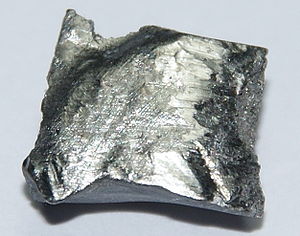Chemical element with atomic number 65 (Tb)
Terbium, 65 Tb Pronunciation (TUR -bee-əm Appearance silvery white
Atomic number (Z ) 65 Group f-block groups (no number)Period period 6 Block f-block Electron configuration [Xe ] 4f9 6s2 Electrons per shell 2, 8, 18, 27, 8, 2 Phase at STP solid Melting point 1629 K (1356 °C, 2473 °F) Boiling point 3396 K (3123 °C, 5653 °F) Density (at 20° C) 8.229 g/cm3 [3] when liquid (at m.p. ) 7.65 g/cm3 Heat of fusion 10.15 kJ/mol Heat of vaporization 391 kJ/mol Molar heat capacity 28.91 J/(mol·K) Vapor pressure
P (Pa)
1
10
100
1 k
10 k
100 k
at T (K)
1789
1979
(2201)
(2505)
(2913)
(3491)
Oxidation states 0,[4] [5] +3 basic oxide) Electronegativity Pauling scale: 1.2 (?) Ionization energies 1st: 565.8 kJ/mol 2nd: 1110 kJ/mol 3rd: 2114 kJ/mol Atomic radius empirical: 177 pm Covalent radius 194±5 pm Spectral lines of terbiumNatural occurrence primordial Crystal structure hexagonal close-packed (hcp) (hP2 ) Lattice constants a = 360.56 pmc = 569.66 pm (at 20 °C)[3] Thermal expansion at r.t. poly: 10.3 µm/(m⋅K) Thermal conductivity 11.1 W/(m⋅K) Electrical resistivity α, poly: 1.150 µΩ⋅m (at r.t. ) Magnetic ordering paramagnetic at 300 K Molar magnetic susceptibility 000 × 10−6 3 /mol (273 K)[6] Young's modulus 55.7 GPa Shear modulus 22.1 GPa Bulk modulus 38.7 GPa Speed of sound thin rod 2620 m/s (at 20 °C) Poisson ratio 0.261 Vickers hardness 450–865 MPa Brinell hardness 675–1200 MPa CAS Number 7440-27-9 Naming after Ytterby (Sweden), where it was mined Discovery and first isolationCarl Gustaf Mosander (1843)
Category: Terbium references
child table, as reused in {IB-Tb}
References These references will appear in the article, but this list appears only on this page.
^ "Standard Atomic Weights: Terbium" . CIAAW . 2021.^ Prohaska, Thomas; Irrgeher, Johanna; Benefield, Jacqueline; Böhlke, John K.; Chesson, Lesley A.; Coplen, Tyler B.; Ding, Tiping; Dunn, Philip J. H.; Gröning, Manfred; Holden, Norman E.; Meijer, Harro A. J. (2022-05-04). "Standard atomic weights of the elements 2021 (IUPAC Technical Report)" . Pure and Applied Chemistry . doi :10.1515/pac-2019-0603 . ISSN 1365-3075 . ^ 3.0 3.1 Arblaster, John W. (2018). Selected Values of the Crystallographic Properties of Elements . Materials Park, Ohio: ASM International. ISBN 978-1-62708-155-9 ^ Yttrium and all lanthanides except Ce and Pm have been observed in the oxidation state 0 in bis(1,3,5-tri-t-butylbenzene) complexes, see Cloke, F. Geoffrey N. (1993). "Zero Oxidation State Compounds of Scandium, Yttrium, and the Lanthanides". Chem. Soc. Rev . 22 : 17–24. doi :10.1039/CS9932200017 . Arnold, Polly L.; Petrukhina, Marina A.; Bochenkov, Vladimir E.; Shabatina, Tatyana I.; Zagorskii, Vyacheslav V.; Cloke (2003-12-15). "Arene complexation of Sm, Eu, Tm and Yb atoms: a variable temperature spectroscopic investigation". Journal of Organometallic Chemistry . 688 (1–2): 49–55. doi :10.1016/j.jorganchem.2003.08.028 .
^ La(I), Pr(I), Tb(I), Tm(I), and Yb(I) have been observed in MB8 − clusters; see Li, Wan-Lu; Chen, Teng-Teng; Chen, Wei-Jia; Li, Jun; Wang, Lai-Sheng (2021). "Monovalent lanthanide(I) in borozene complexes" . Nature Communications . 12 (1): 6467. doi :10.1038/s41467-021-26785-9 . PMC 8578558 PMID 34753931 .
^ Weast, Robert (1984). CRC, Handbook of Chemistry and Physics . Boca Raton, Florida: Chemical Rubber Company Publishing. pp. E110. ISBN 0-8493-0464-4 ^ 7.0 7.1 Kondev, F. G.; Wang, M.; Huang, W. J.; Naimi, S.; Audi, G. (2021). "The NUBASE2020 evaluation of nuclear properties" (PDF) . Chinese Physics C . 45 (3): 030001. doi :10.1088/1674-1137/abddae . Lua error in mw.title.lua at line 229: too many expensive function calls.


